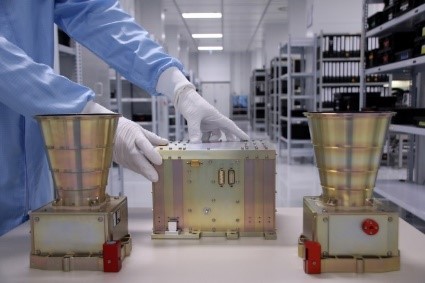European company’s all-star solution generates 10 million EUR in sales

Next time you look at the night sky, bear in mind that your favourite constellation is probably being used to steer and orient spacecraft. Thanks to German company Jena-Optronik and ESA’s ARTES programme, that has just become a whole lot easier.
‘Star trackers’, or star sensors, are used on satellites to determine the precise orientation or ‘attitude’ of the spacecraft in relation to the stars. The star tracker measures the position of many stars and compares it to a star catalogue, allowing the attitude of the spacecraft to be calculated.
Although these star tracker sensors are used for the attitude and orbit control systems of spacecraft, they have temporary outages when ‘dazzled’ by strong light sources such as the sun, or the sun’s reflection off parts of the spacecraft. Star trackers therefore work in tandem with gyroscopes, as the latter provide temporary, albeit less accurate, attitude information during star tracker outages. Together, star trackers and gyros ensure that the satellite’s attitude is always known.
State-of-the-art attitude determination systems for telecom spacecraft typically use two star trackers along with gyroscopes, which are separate units on board the spacecraft. The main spacecraft computer is then tasked to process the star tracker and gyro data.

German company Jena-Optronik GmbH,which specialises inelectro-optical precision sensors and components for space applications, recently set on a course to make attitude determination more reliable, while reducing the cost and complexity of satellite platforms. Enter the next-generation star tracker system: ASTROgyro™. Created and co-funded by Jena-Optronik and ESA’s ARTES Competitiveness & Growth programme, ASTROgyro is an innovative system that combines the advantages of star trackers and gyroscopes, as well as data processing, into one product.
The system reduces computational loads for the satellite’s computer by pre-processing, monitoring and harmonising the data of two previously independent technologies.
This integrated yet flexible system substantially increases the respective attitude performance, whilst also improving operational availability and robustness.
Jena-Optronik will be the first European supplier to offer this product on the world market and ASTROgyro has already received enthusiastic feedback from major satellite primes.
ASTROgyro’s arrival on the market has not only spawned a new market segment, but has generated additional jobs and more than 10 million EUR in sales.
“The development of ASTROgyro is a notable step in the continuous improvement of satellite-assisted telecommunications services, in terms of accuracy and robustness. It will reduce the cost of the star tracker/gyro subsystem and help increase the global demand for European space products,” said Torsten Vogel, Space Segment Engineer, European Space Agency.
Mario Rößler, Project Manager at Jena-Optronik, said: “Thanks to ESA’s ARTES programme, Jena-Optronik was put in the position to add ASTROgyro as a new product to its portfolio. The ARTES programme was flexible enough to support the whole development cycle. The excellent working relationship with the ESA team has assured a smooth project progress in spite of many challenges. First flight models will be delivered to an international commercial customer by the end of 2018. This is a good example of how the ARTES programme has contributed to strengthen the capabilities of the European Satcom industry.”




